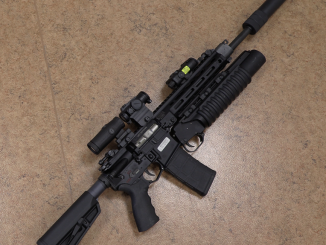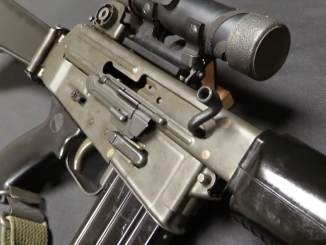This is Lot 1037 in the upcoming October 2019 Morphy Extraordinary auction.
After yesterday’s history and disassembly, I had a chance to take the Hyde/Marlin M2 submachine gun out to the range today for some test firing. It is a remarkably nice gun to use – with a good in-line stock design and low rate of fire, it was extremely controllable. Better than both the Thompson (in any of its forms) and the M3 Grease Gun, in my opinion. I think this is one of a very small number of guns which were actually really excellent despite being cancelled or abandoned before seeing substantial military service.




Does this particular item have potential for a comeback in law enforcement application if the design were modernized? Or is it too late?
There’s not much point nowadays – locked-breech weapons like the MP-5, or telescoping-bolt blowback options will be even better in terms of weight and length reduction, without any loss of performance. The telescoping bolt, in particular, is a much more elegant approach than the M2’s ‘big-bolt’ strategy.
Also, while pretty cool, I imagine that the metal sintering used to create the receiver would pose almost as many manufacturing issues today as it did in 1942, simply because it is not commonly used in firearms manufacture, especially at a small-scale.
It is a shame that this never saw wide-scale manufacture back in the war, though. Compared with the almost comically-crude M3, this looks like a much more comfortable, ergonomic, and consequently, effective weapon. If the weapon had reached mass-production, examples probably would have lingered in US and Allied arsenals for decades into the Cold War.
Correction: The above should read ‘delayed-blowback’, not ‘Locked-breech’ with regards to the MP5
Well, if the design did away with the metal sintering and went for a simpler bolt and receiver setup, it might have stuck around during the Cold War.
Yeah, looking at it, its not so complicated part that forging with simple machining could not replace it, or even made from round stock with welded or brazed magazine well.
Bolt certainly has aussie Owen vibes in it, like back fat portion is enclosed to prevent grit and junk ingress.
When Ian revealed the small spring inside the large spring upon disassembly (prior M2 SMG video) I speculated that, unlike the replica semiautomatic M2, the real M2 would be soft-firing. That extra spring would prevent the bolt from slamming against the back of the receiver and increasing recoil.
I’ve fired the M3A1 once, perhaps 20 rounds, and found it very controllable at the distance of 25 or 35 meters. I’ve fired a few other submachine guns such as the MP-40, a clone of the S&W M76, the Uzi and the MP-5. I didn’t shoot them enough to develop a preference. Though only 400 M2 SMGs were made, the number of the long-lived M3 and M3A1 made wasn’t very large compared to the Thompson family: 606,694 M3 SMG (at $17 each) and 48,669 M3A1. Compared to the 6,121,309 M1 Carbines produced during the Second World War, the total submachine gun production of the United States was about half–the USA didn’t go for the submachine gun as much as did the USSR or Britain or Germany.
I’d have to go along with the US Army’s decision to make the M3 submachine gun at $17 each instead of the more-expensive M2 submachine gun despite performance advantages of the M2–the submachine gun was more likely to be stowed in a tank and left there than to participate in house-to-house fighting. My impression of M3 submachine gun issue was that a small number were distributed to infantry battalions as special purpose weapons (raids and such), to Military Police, to parachute troops and to armor (as vehicle equipment for tanks and other armored fighting vehicles). The M3 is more compact–and of greater importance, cost far less than the M2.
Too bad that the M2 wasn’t available in quantity during 1941. “Chief, missed it by that much!” It would have given the M1 Carbine more competition.
If they could have made m1 carbine in full auto with reliable 30 round mag that could fire in 400-500 rpm, it would maybe present a small arms gamechanger, not in Stg44 fame and fashion, but very close.